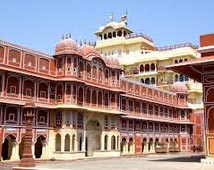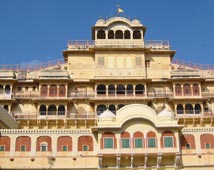
Splendidly unique and exquisite, City Palace is located in the capital of Rajasthan and is a perfect example of traditional Rajasthan and Mughal architecture. Originally built by Maharaja Jai Singh II of the Kachhwaha clan of Rajputs, developments have been made to the palace complex by many of his successors. The City Palace stands majestically on the hill guarded by crenelated fort walls. In contrast to its rough exterior, the inside presents a delicate and exquisite world of beauty with lavish use of marble, mirror work, frescoes, wall paintings, silver doors, fountains and gardens.
The City Palace consists of four main palaces. The Palace of Joy, Dilkusha Mahal, is lavishly decorated with frescoes and paintings. Moti Mahal, or Palace of Pearls, Sheesh Mahal, or Palace of Mirrors, and Krishna Mahal are decorated with colours and paintings. The ground and first floor of the Chandra Mahal, form the Maharaja Sawai Man Singh Museum. The museum has an extensive collection of art, carpets, enamelware and old weapons. The paintings include miniatures of Rajasthani, Persian and Mughal schools. The Mubarak Mahal, or the Auspicious Palace, contains the textile section of the museum.
Diwan-I-Khas & 'Diwan-E-Aam
There is a imposing gateway with a lofty door in brass opening to a regal courtyard. There lies the Diwan-I-Khas or 'Hall of Private Audience'- an open hall with a double row of columns with scalloped arches. Across the paved square, with its elaborate decorations in deep red and gold, Afghan and Persian carpets, miniature paintings, astronomical manuscripts in Persian and Sanskrit lies the 'Diwan-E-Aam' or the 'Hall of Public Audience'. At the other corner is the gateway Ridhi Sidhi Pol, with four small doorways decorated with motifs depicting the four seasons.
Mubarak Mahal
Built by Maharaja Madho Singh II in the late 19th century, the Mubarak Mahal,
or the Auspicious Palace, contains the textile section of the Maharaja Sawai
Man Singh II Museum.

Chandra Mahal
Situated in north-west is the commanding and elegant Chandra Mahal, the
residence of ex-ruler. The seven-storey Chandra Mahal is the center-piece
and exudes fine views of the gardens and the Jaipur city. The complex contains
an excellent museum, an armory and several fine halls. The museum of Maharaja
Sawai Man Singh II has an extensive collection of art, carpets, enamelware
and old weapons. The paintings include miniatures in Rajasthani, Mughal
and Persian schools. Each storey has a distinctive name and is a place of
sheer beauty and luxury. The uppermost storey is called the Mukut Mahal.
Sukh Nivas & Shobha Nivas
'Sukh Nivas' or "Hall of Rest" is the drawing and dining room of the Maharaja, furnished with Mughal miniatures, European silver, glass dining tables and peep holes decorated with gold leafs, for ventilation. On the fourth floor of the Chandra Mahal is the 'Shobha Nivas' or "Hall of Beauty" with mirror encrusted walls having exquisite blue tiled dadoes and glittering gold leaf and mica decoration. The Shobha Nivas and the Sukh Nivas is still occupied by the present Maharaja.
Badal Mahal
Lying opposite to Chandra Mahal the Badal Mahal has extensive and sprawling gardens. The Govind Devji Temple stands in the middle of the Chandra Mahal and the Badal Mahal. A delightful system of mountains is placed in the middle of the paved path between the Chandra Mahal and the Badal Mahal.